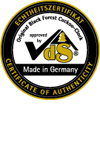
What are your plans for the weekend or next holiday ? Why not travel along the Route of the Black Forest Clocks? It will take you to some of the most beautiful sceneries of the Black Forest.
The route is almost 300 kilometers and takes you through one of the most beautiful sceneries of the Black Forest. We are talking about the Route of the Clock in Germany, one of the most attractive routes for tourists besides the Romantic Route and the Schwäbisch Baroque Route. Like pearls on a string you find such lovely places as Triberg, Furtwangen, St. Märgen, Eisenbach or Titisee-Neustadt. And to the expert names like Waldau, Schönwald or Villingen-Schwenningen also ring familiar.
The town of Furtwangen has now been the center of the Black Forest Clock area for a long time. Today its clock museum has gained a world-wide reputation. The by far largest collection of old German clocks has its origin in the clock-makers´school that was established here in the 19th century. The first headmaster was Robert Gerwig. This man set himself a lasting monument with the Black Forest Railway initiated by him. In 1852 Gerwig urged people to keep and collect the old hand-carved wooden clocks. By this he brought together the first pieces of the Furtwangen collection which consists of more than 4 000 objects today.
Not far away lies the beautiful holiday retreat Schönwald, where the inventor of the first cuckoo clock Franz Kellerer lived. He was the first one who succeeded in imitating the cry of the cuckoo with the help of two different sounding whistles.
The name of Triberg is closely connected to the waterfall nearby. When you arrive at the entrance to the falls in the morning you will find a whole lot of squirrels waiting for a second breakfast. In this picturesque town lives the only cuckoo clock-maker who actually produces the complete clock consisting of clockwork, house and carving. The Black Forest Museum in Triberg is also worth a visit. You should not miss the largest collection of grind-organs in Europe as well as the impressive collection of antique Black Forest Clocks. The museum is located above the entrance to the waterfalls.
Leaving this lovely little town you soon reach Schonach which lies a few kilometers above in a high valley. Schonach is one of the centers of cuckoo clock-making.
Following the route up past Hornberg you will reach Schramberg – the five valley town – and home of Junghans. The reputation of this firm is based on the radio controlled wrist-watch they produce. You should not miss the unique collection of industrial clocks in the town museum. The well chosen examples of former methods of production and working conditions give the visitor some interesting information on the social and economical history of this area.
Königsfeld which is 800 meters above sea-level is especially favoured by older residents and guests as it provides about 200 kilometers of almost plain walking paths. And here, right in the center you will find the clock-making business of Peter Auber. He has a passion for old clocks with hand-painted enamel fronts which he rebuilds after old models. He even successfully rebuilt the legendary “Sorg -clock” from Neustadt.
A few kilometers away from Königsfeld your route leads you to Villingen-Schwenningen, the most important center of the Black Forest Cuckoo Clock in the past. Particularly the district of Schwenningen was formerly regarded as the biggest clock-making town of the world. You really should not miss the two museums with their different collections of clocks. If you are interested in the history of the alarm-clock you should certainly have a look at the early examples of industrial clocks located in the former Bürk-Factory. In no time you will reach Trossingen which really is not far away and Trossingen is a paradise for handicraft enthusiasts who want to make their own clock. The firm Selva provides a wide range of more than 10 000 items where the hobby clock-maker is sure to find almost everything he needs, be it cogwheel, pendulum or weight.
But back to the origin of the Black Forest Clock: This journey along the Route of the Clock finally takes you to Eisenbach where Johann Baptist Beha once built his famous table cuckoo clocks. In the hotel “Bad” you can admire his world time clock from 1865 which is proudly cared for by his descendants.
Finally we arrive in the area around Titsee-Neustadt which is said to be the actual cradle of the Black Forest Clock. Here is the home of the famous “Jockele” or “Sorg” clocks – the favourite pieces of every collector. Even the nearby Lenzkirch has formerly been an important center of clock-making.
You can start your “Journey around the Clock” at many places, for example in St. Märgen or St. Peter with their Baroque monasteries. Even Waldkirch, though situated in the Breisgau, is a clock-making town with a long tradition.

 English
English


 With the VDS Certificate of Authenticity you can be sure to own a genuine Black Forest Clock!
With the VDS Certificate of Authenticity you can be sure to own a genuine Black Forest Clock! Need service for your genuine Black Forest Clock in the USA, Australia, Japan or somewhere else?
Need service for your genuine Black Forest Clock in the USA, Australia, Japan or somewhere else? Verein die Schwarzwalduhr
Verein die Schwarzwalduhr